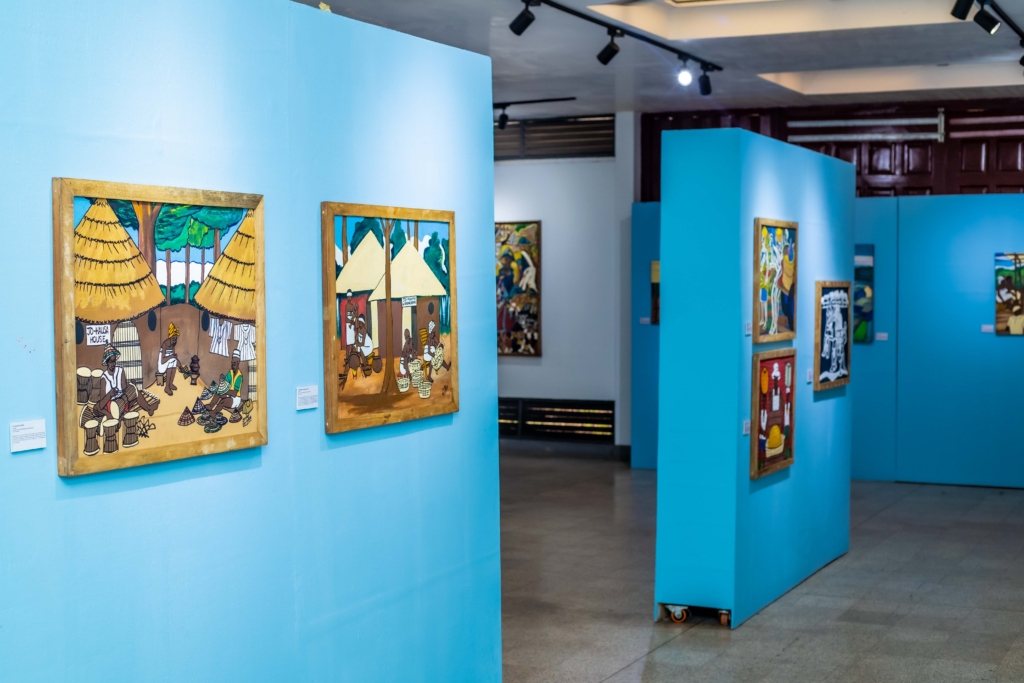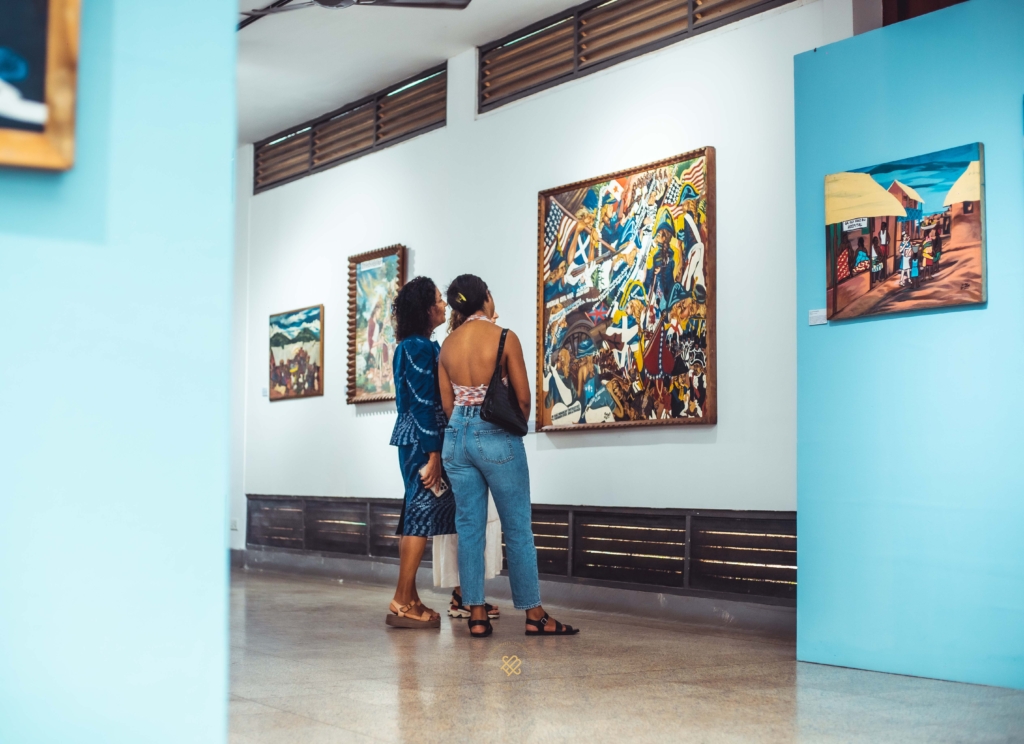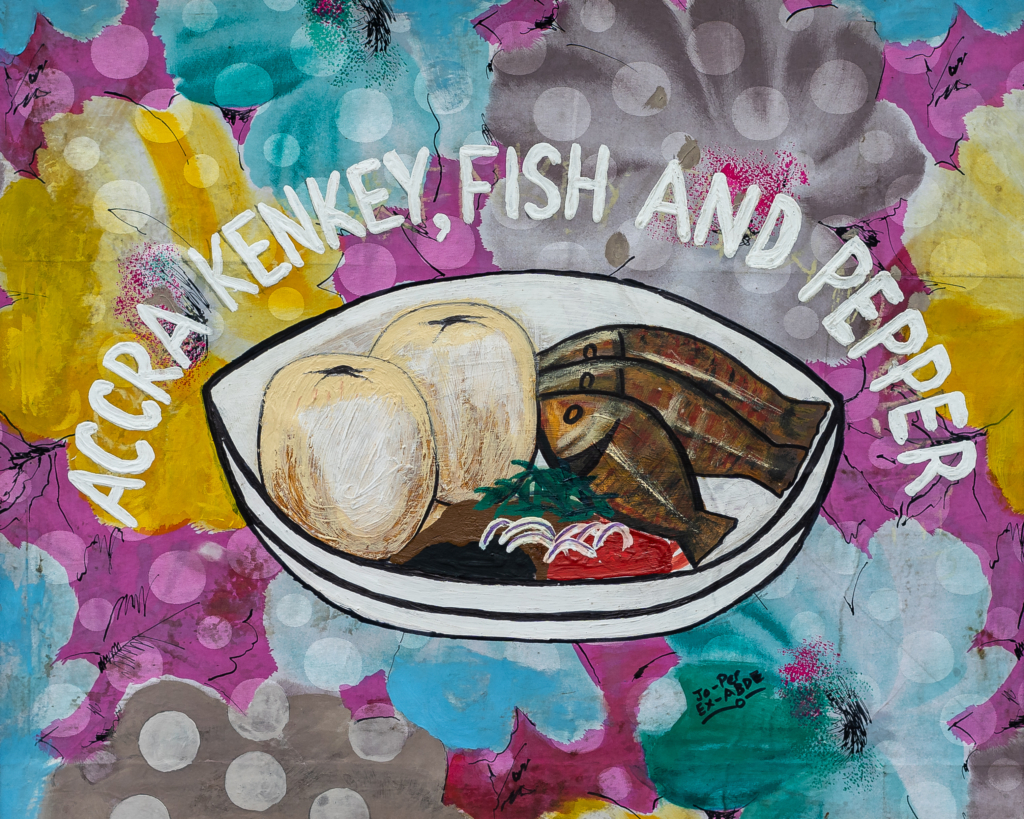Jojo Abdallah has kept up a studio in the Accra Psychiatric Hospital for the past 45 years, alternating between staff, patient, and artist-in-residence.
One of his creations in that area is a hand-painted sign for the hospital’s studio and occupational therapy department. The phrase “Psy-Technology” on that signboard served as the basis for the name of his latest solo exhibition, JOJO ABDALLAH: PSY-TECH.
The exhibition, which is curated by Robin Riskin, looks at how technology, psychology, and art interact. Abdallah’s exhibition features paintings and mixed-media pieces that portray many aspects from Ghanaian cultural, political, and spiritual life, like as mental hospitals and traditional ceremonies.
Jojo Abdallah: Compound House Gallery, the Ghana Museums and Monuments Board, and the Accra Psychiatric Hospital work together to produce Psy-Tech.
Riskin discusses his observations on the show in this interview.
What was Jojo’s intention for this show when you first spoke with him? What’s on display resulted from which conversations?
This is Jojo’s second show at the National Museum of Ghana in the last two years; he actually started the exhibition. He is an unwaveringly dedicated artist who will use any means necessary to produce and will find a way to share it. As soon as his previous exhibition ended, Jojo began work on the body of work in PSY-TECH; this collection is somewhat more thematic.

The artwork delves into several aspects of Ghanaian history and healthcare, including trade, travel, science, technology, syncretic spirituality, knowledge systems, and Jojo’s own avatars. A significant emphasis is placed on Ghana’s evolving ecological and political conditions, as well as Ga culture at the nexus of urban and rural life.
Jojo didn’t plot the topics; instead, he just followed his own list of stories that he wanted to convey in order of preference. I searched the collection in retrospect and found the resonant clusters. Both the narrative flow in the exhibition catalogue and the physical flow within the Ghana Museum are directed by these thought-clusters.
Jojo’s own attitude and the stunning sea blue signboard that identifies his workshop in the Accra Psychiatric Hospital’s Occupation Therapy department are the sources of the idea behind PSY-TECH. “PSY-TECH,” in my opinion, refers to the way that spirituality, technology, and psychology are intertwined when it comes to exploring different realms and creativity.
PSY TECH has a syllabus as well. Psy-Chy art is a rhythm that encourages creativity and demands your whole concentration. It’s a world that you may see within the world as well. You observe human beings and the motions of other vibrant, living animals. That’s a world too. It’s fascinating to see how open you are and what they’ve provided you in terms of mental health. Psychiatric Tech is my name. —Jojo Abdallah, PSY-TECH exhibition opening, June 29, 2024.
Could you explain the background to Jojo’s paintings, which depict life at the nexus of history and fantasy?
Jojo’s “fantasy history paintings” feature real people, places, and events, but they juxtaposition and combine the images in ways that don’t seem to make sense. For example, Gold Coast and Independence Republics might jointly honor a building or marketplace, or Ga, Fante, Brong, and Gold Coast can all be networked in the same signboard. It’s possible that, from Jojo’s point of view, the British, French, Romanians, “Jojo Kennedy,” and “Ga’s of Saudi Arabian Jews” were all involved in the American Civil War. Furthermore, “So-Lo” Elohim and cosmic flying squirrels may be the source of the “Holy Spirit” of the Roman Catholic Church.

Despite its seeming absurdity, there is a deeper logic to it when we take into account the histories of transatlantic trade, transAfrican exile, and etymological and technical progress. It was crucial to me to embrace Jojo’s freed connection with language and to release his creativity rather than to control or define it. Jojo claims to have researched his pasts through libraries, museums, schools, the media, and news sources. However, I’m never sure what goes on in his head while he’s staring at a page or a screen. This otherworldliness drew me in naturally, and I wanted to spread it to others.
When psychiatric facilities in Ghana are mentioned, people frequently react negatively. Was that the first thing on your mind when you started organizing this exhibition?
In a big way. I didn’t want to romanticize or belittle Jojo’s psychological illness—schizophrenia, which you may have noticed I haven’t yet discussed—in favor of focusing on his artistic output. I believe that everyone is on a spectrum, and those who choose to pursue careers in art simply give it more room in our daily lives. I don’t think Jojo and I are all that different from each other—I too have what you would term “disorderly and tangential thinking and communication,” and I can hear or see voices and sights from other dimensions if I so choose. That reminds me of prayer, creation, manifesting, searching, and intuitive abilities. I curate Jojo’s work with an intimacy that comes from being inside it and trying to learn from it rather than from a distance.
Conversely, even though I downplayed Jojo’s medical state, I wanted to draw attention to the Accra Psychiatric Hospital’s involvement in the creation of the show. It was significant for me to organize an exhibition through the cooperative interaction of a state museum (the National Museum of Ghana), a state hospital (the Accra Psychiatric Hospital), and an experimental artist-led gallery (Compound House Gallery, founded by my dear friend and blaxTARLINES peer Nuna Adisenu-Doe). This is because I come from the blaxTARLINES KUMASI art community, where inter-institutional networking has been crucial for regenerating cultural infrastructure from within.

Jojo’s creative journey was shaped in part by the Psychiatric Hospital, and hospitals are a recurring theme in his works. Writings on art and treatment were included in the exhibition catalogue by Doctors Ekremet and Quartey as well as Dr. Enyin Bentum “Paakow” Annan, a physician and art enthusiast who coincidentally began volunteering at the Psychiatric Hospital the week after he met Jojo.
Over the years, the hospital has served as a go-between for Jojo and the Ghana Museum and Monuments Board. In the 1990s, Jojo and other patients were the subject of several performances organized by the then-Hospital Director, J.B. Asare. I’ve been told by Jojo’s family that he has maintained a studio at the Hospital for 45 years, yet he will tell you that he has only been there for 25. The room has given him a certain freedom and network of support for his art that defies the common perception of hospitals as silent, antiseptic, and sacred spaces.
Furthermore, this is no typical state hospital—it was founded in 1906 as the Lunatic Asylum on the colonial Gold Coast, during a period and under a system in which mental health patients were treated almost like slaves. Ghana’s independence and modernization brought about changes in the situation, and the Accra Psychiatric Hospital that exists today is dedicated to providing therapy and care. Thus, the history of the Psychiatric Hospital is a tale of metamorphosis with application to the curatorial profession. In the process of institutionalizing art objects and the cultures that surround them, how do we resolve the conflict between control and care? How may the porousness, joy, and force of daily existence and creation be infused into healthcare settings?

Was it intentional to focus on everyday life in Ghanaian society rather than just the hospital in this show?
Indeed. When I first started working on the exhibition, I truly believed that Ghanaian hospitals were the focus of Jojo’s paintings. Upon bringing the piece to the Museum to explore other layout options, I realized that the central theme was Ghanaian culture as a whole, of which hospitals are just one essential aspect among many. It became evident upon entering the Museum—a place where generations of cultural knowledge loom large—how Jojo’s art contributes to the endeavor of narrating these stories through poetry and fantasy as opposed to hard truth and verification.
The emphasis on Ga culture and history in Jojo Abdallah’s body of work for PSY-TECH is a result of the artist’s upbringing in the Asylum Down and Adabraka neighborhoods of Accra. Image: Compound House by Nathaniel Boateng
Upon entering the exhibition, one is immediately confronted by Jojo’s well-known paintings of “Accra Psychiatric Hospital” and “Ga’s First Awaking,” which are inspired by the Museum’s collection of artifacts and ancestral traditions. Across traditional, colonial, and modern regimes, these paintings jointly depict tales of Ghana’s shifting social fabric: the hospital as part of the society, and the society as part of the hospital.
Coincidentally, the University of Michigan Museum of Art, blaxTARLINES (the painting and sculpture department at KNUST), and the Ghana Museums and Monuments Board are collaborating to present an exhibition at the museum that explores artistic production surrounding Ghanaian independence through the recentring of art of radical difference. You may consider Jojo’s artwork to be an addition to this project, or as another one of our worlds inside worlds.
Jojo Abdallah’s paintings are arranged at the PSY-TECH show into miniature worlds inspired by the cosmos in Abdallah’s dreams. Pictured at Compound House Gallery by Nathaniel Boateng
How did you go about assembling this exhibition? How did you choose which pieces of work to include? Does curating this show reflect your role as an artist? If so, how?
Jojo’s own voice and vision, which she weaves with a group of “curatorial companions,” serve as the foundation for my curatorial endeavor. By showing Jojo’s work to his and my creative communities—which include writers, musicians, doctors, designers, friends, and family—I sparked a series of discussions about his art. By combining bits and parts of these conversations into textual, aural, visual, and cinematic works, my curation tells the story of Jojo’s artwork. I created a few of these pieces myself, and others were created by others who naturally participated in the process.

Family members of Jojo Abdallah watch his fantastical historical paintings during the PSY-TECH exhibition’s launch at the Ghana National Museum. Pictured at Compound House Gallery by Carl Segbefia
This endeavor is what I refer to as “schizophonic curating,” though I have also termed it mycorrhizal, fungus, folkloric, and other terms at different times. The idea is to progress toward networked, polyrhythmic, poetic, abstracted, and interpersonal pieces and processes and away from expectations of omniscience, authority, objectivity, or singularity. Why? Curating, which is responsible for defining, characterizing, and packaging goods for widespread distribution and consumption, has been caught in the same “monocrop” issues as other contemporary sectors. However, as life is complex, dynamic, multifaceted, and incompletely understood, how might our narrative frameworks for mediating art take it into account?
I was interested in reinterpreting Jojo’s clinical situation through ancestral knowledge systems and connecting his work to alternative canons for PSY-TECH. Shamans, diviners, and healers in communal and Afro-indigenous societies would communicate with voices and visions from spiritual sources that the general public could not access. This was considered a strength and a gift rather than a sickness or ailment. I pondered how my curation could respect Jojo’s viewpoint and experience by embracing its fragmented and mixed approach to reality and learning from, loving, and applying it.
The captioning of the pieces through Jojo’s incoherent dialogue, the exhibition catalogue’s transitions between poetry, prose, therapy, and bricolage, the teleportation of textual and aural essays between subjects, spaces, and universes, and the PSY-TECH interventions’ infiltration of social media are all examples of these strategies in action. Hence, rather of impeding or stifling Jojo’s creativity, my curation functions as a creative cloak. As I was unable to frame it completely, I chose to create openings for the indescribable process of interpretation.
What else would you like to draw attention to?
My teacher at the Kwame Nkrumah University of Science and Technology (KNUST) in Kumasi, kąrî’kạchä seid’ou, gave me the notion to reinvent curation as a creative medium. Among other things, he redesigned the dynamics of the KNUST College of Art by empowering artists to take charge of their curatorial frameworks and curators to take charge of their exhibitionary forms and procedures. This straightforward but thought-provoking question changed my perspective on both art and life in general. I had to detach myself from curating forms as I had known them and search for models in healers, artists, ecologists, fig trees, forests, fungus, and language itself. I was able to give these speculative, abstract, and social processes a concrete form by working with Jojo. My curation was liberated by his blend of factual fluidity, narrative intricacy, and in-depth investigation.
I should also mention that in 2019, while Nii Otoo Annan and Muziki were performing in the Psychiatric Hospital, it was artist Nii Noi Nortey who first introduced me to Jojo. Their friend and longstanding partner Steven Feld, an American musician and ethnomusicologist who has worked with creatives in Ghana for the past 20 years, is where I got the idea for “schizophonic” curation.
Some of the materials I studied with kąrî on ethnographic paradigms in community art were impacted by Feld’s studies on the politics of reproduction surrounding polyrhythmic sound. I wondered how oral and rhythmic communication could be resonant means for telling and generating culture, like Feld, Nortey, Annan, John Collins, Jesse Weaver Shipley, Panji Anoff, Reggie Rockstone, Colter Harper, and other musical philosophers who bridge the gap between theory and practice.
